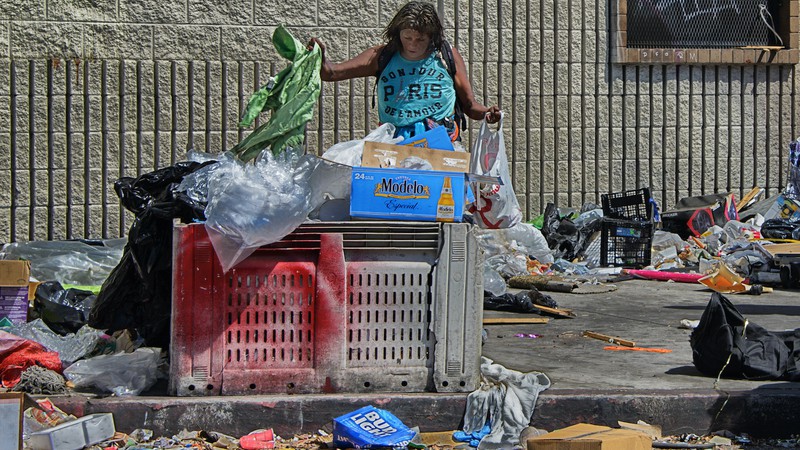As homelessness surged in California, it dropped by a third in Texas. Why?

Should California adopt the Texas approach to handling the homeless problem? Russ Allison Loar / Wikimedia Commons C.C. Share-Alike 4.0 License
BY
When looking at the numbers, there’s no question Texas is doing a better job of mitigating homelessness than California.
For one thing, Texas’ homeless population shrunk by nearly a third over the past decade, while California’s grew by 43 percent, according to the federally mandated point-in-time count. And in the Golden State, 439 people are homeless for every 100,000 residents compared to 81 in the Lone Star State.
Can California homeless services get similar results by copying Texas? It’s not that simple. Things are very different in California, and here’s a brief look at why:
Texas Builds More Homes Than California
One advantage Texas has over California when it comes to addressing homelessness is the Lone Star State’s ability to build. Last year, 265,793 homes were permitted in Texas, compared to just 119,667 in California, according to the U.S. Department of Housing and Urban Development. That’s less than half as many as Texas, even though California has about 9 million more residents.
Many experts say part of the problem is the heaps of red tape developers must navigate to get anything built in California. The state’s signature California Environmental Quality Act, which Gov. Gavin Newsom is attempting to reform, allows opponents of projects to block them in court for years, sometimes leading to their demise.
In the Golden State, 439 people are homeless for every 100,000 residents compared to 81 in the Lone Star State.
Not only does Texas have no such law, it has fewer building regulations across the board. Land in unincorporated counties, for example, isn’t subject to zoning. That allowed for the 2015 opening of Community First! Village, a neighborhood with 350-and-counting tiny homes for homeless residents just outside Austin’s city limits.
In addition, there are no zoning ordinances in the entire city of Houston. That lack of regulation, coupled with a strong mayor who can push projects through, makes it easier to get homes built in Texas’ largest city.
Last year, Houston permitted 15,745 homes. Los Angeles permitted 16,707, but it has 1.5 million more people and four dozen zoning districts with different rules on what developers can and can’t build.
Everything is Much More Expensive in California
It’s impossible to leave cost out of the equation. The median rent for a one-bedroom home in California was $2,200 in June, compared to just $1,223 in Texas, according to Zillow.
In Houston, Texas’ biggest city, that price is $1,202. Compare that to Los Angeles, California’s largest city, where the median rate is $2,198.
Last year, Texas put $19.7 million of state funding into its three main homelessness programs—equal to about $806 per unhoused person. California poured $1.85 billion into its three main programs—or $10,786 for every unhoused person.
Texas also has more homes available. Its rental vacancy rate was 10.2 percent in the first quarter of this year—one of the highest in the country—compared to just 4.1% in California, according to U.S. census data.
Little State Funding for Texas Cities, but Outsized Federal Resources
Texas gets by almost entirely on money from the federal government and private donations, whereas California recently has made large contributions in state funding to homeless services.
Last year, Texas put $19.7 million of state funding into its three main homelessness programs—equal to about $806 per unhoused person. California poured $1.85 billion into its three main programs—or $10,786 for every unhoused person.
Houston puts no city money into homelessness. Instead, service providers there rely on federal funding—of which they get an outsized amount. The Houston area received $45.2 million for homelessness from the U.S. Department of Housing and Urban Development in 2021, or about $14,483 for every homeless person in the region. Leaders there say they win extra federal dollars because they’ve proven that their strategies work.
Los Angeles County got $155.4 million—but that equates to just $2,386 per unhoused person. San Francisco got $6,629 per unhoused person, and Sacramento County got $3,203.
Two of Texas’ most well-known homelessness programs—Austin’s Community First! Village of tiny homes and San Antonio’s massive, 1,600-bed shelter—were founded on private donations.
Texas’ Enforcement-Heavy Approach Wouldn’t Fly in California
Texas is cracking down on homeless communities in a way California is unwilling and unable to do. With support from Republican Gov. Greg Abbott, Texas in 2021 passed a law that makes camping in public places a misdemeanor punishable by a fine of up to $500. Republican lawmakers in California tried to pass versions of that ban this year, but their bills died in committee.
Some California cities recently started prohibiting encampments in certain places, such as near schools, but a federal court ruling severely limits their ability to enforce broader bans. The 9th Circuit Court of Appeals, whose rulings govern nine Western states ruled cities cannot penalize someone for sleeping on public property if there are no other options. Cities have interpreted that to mean they can’t clear a camp unless they have shelter beds for all its occupants.
Leaders in Texas have no such court ruling tying their hands. Even so, different cities in Texas use different tactics. Houston attempts to get everyone into housing—or into a bed in its brand-new navigation center—before clearing an encampment. In Austin, activists say police force unhoused people to move from camp to camp—often pushing them out of sight into wooded areas far from services.
The article titled “California can’t—or won’t—match Texas’ approach to homelessness. Here are 4 reasons why” appeared first on CalMatters.org.
CalMatters is a nonprofit, nonpartisan media venture explaining California policies and politics.
Articles which extol the virtues of a report or article put out by a local newsroom.